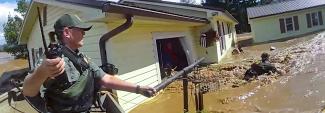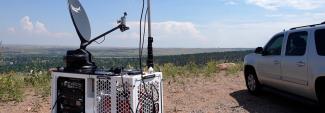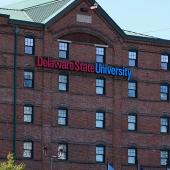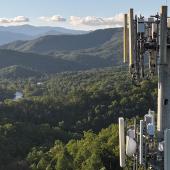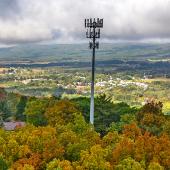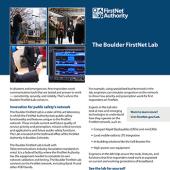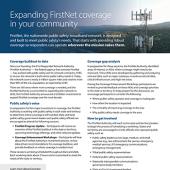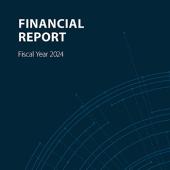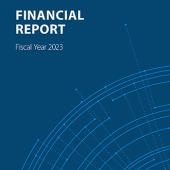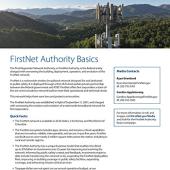Summary
In this episode of Public Safety First, Dave Mulholland — Administrator for the Arlington Co. (VA) Emergency Communications Center — discusses the evolution of emergency communications in the National Capital Region and shares his experiences with a FirstNet demo at the Marine Corps Marathon.
Guest
Dave Buchanan
FirstNet Authority Executive Director of Public Safety Advocacy
Dave Mullholland
Administrator for Arlington County Emergency Communication Center
Transcript
Preview
Narrator: You're listening to Public Safety First, a podcast to help you learn about the First Responder Network Authority and how you can be part of the future of public safety technology.
And now your host, Dave Buchanan.
Dave Buchanan: Welcome to the Public Safety First podcast. Today, I’m in Arlington County, Virginia, where I’m joined by Dave Mullholland, the administrator of the Arlington County Emergency Communications Center. Welcome to the podcast, Dave.
Dave Mullholland: Thanks, Dave.
Narrator: You're listening to Public Safety First, a podcast to help you learn about the First Responder Network Authority and how you can be part of the future of public safety technology.
And now your host, Dave Buchanan.
Dave Buchanan: Welcome to the Public Safety First podcast. Today, I’m in Arlington County, Virginia, where I’m joined by Dave Mullholland, the administrator of the Arlington County Emergency Communications Center. Welcome to the podcast, Dave.
Dave Mullholland: Thanks, Dave.
Dave Buchanan: I’m excited to be here and excited to have this conversation. You’re known to many people in our stakeholder community as a leader in emergency communications and public safety communications. I’m particularly interested in having a conversation about your – the different perspectives you’ve had as a federal law enforcement official, as a statewide interoperability coordinator at the District of Columbia, and now at the local level in Arlington County. We don’t get to encounter many people that have worn three different hats, had three different disciplines, and have gotten to experience public safety communications from those three different vantage points. So, I’m looking forward to this conversation.
So let’s start with your career. How did you get started with the Park Police?
Dave Mullholland: So, I joined the United States Park Police in March of 1988 and thoroughly enjoyed being a police officer – went to the rank of Sergeant and while I was a sergeant, my chief selected me to go on a one-year visiting fellowship to the International Association of Chiefs of Police [IACP] and it was at that time, that I got introduced to public safety technology.
After I left IACP, I maintained my relationship with their technology clearinghouse folks and ultimately became a subject matter advisor for law enforcement operations for them for different technology projects – had the opportunity to be involved in a lot of cutting-edge projects that IACP was conducting. But also thrust me into the standards and specifications environment as well. Working in great partnership with APCO, with the Integrated Justice Information Systems Institute (IJIS Institute), and that really was a springboard to put me into having a good understanding of what’s going on in the technology world today, but more importantly, having that vision for what’s coming five, ten, fifteen years down the road.
Dave Buchanan: What were the challenges that you experienced at the Park Police with public safety communications when you first got started? What were the cutting-edge issues at that time?
Dave Mullholland: The biggest concerns of the time were probably just a lack of resources, so some of that might be a lack of availability of resources to just even communicate with each other. Back then, everything was predominately land mobile radio driven, and there was really no capabilities that were deployed at that time for folks to even interconnect between radio systems. Interoperability was simply – call your dispatch center, have them call a dispatch center, have them talk to somebody, who talks back to dispatch center, who talks back to our dispatch center, who talks to the field. A lot of room for information distortion to take place there. There was really no use of other informational gathering tools, such as video, at the time. Video was really becoming, in the mid-90s to late-90s more pervasive throughout, but even then, it was stand-alone video systems that could be viewed maybe at one location. So the opportunity to have information that could really substantially change how you respond to, and how you manage an incident, was just not available to the decision- makers.
Dave Buchanan: So then you moved on to the District of Columbia, where you were the statewide interoperability coordinator. What was that job like? What was the takeaway from that experience for you?
Dave Mullholland: So during the time that I was there, the ‘biggie’ that we handled was the 2017 inauguration, which was massive. What it did was, it took what we experienced every day at a much smaller level within the National Capital Region of interoperability, and it exploded it to unusual levels. So, 114 law enforcement agencies from across the country that are imported into the District, just to assist; 13 to 15,000 National Guards members that come into the city just to assist; public safety, which during my time at IACP and the work that I did with them, really helped me underscore how global it is. It’s not just police. It’s not just fire. It’s not just EMS. There’s a whole ‘rest of the public safety world’ that transportation, human services, all those folks have a role in that. So, as the SWIC, the job was difficult, because what I had to do was get a lot of different folks with a lot of different perspectives, and a lot of driving reasons why they still would want to be territorial and parochial, to come to the table, share, work together, and make the assets that they had to collect and disseminate information available to each other.
Dave Buchanan: So, what was the big communications challenge then? This is January of 2017, it’s about two years ago now. This was before FirstNet, obviously. What were the communication challenges that you dealt with two years ago?
Dave Mullholland: So, in general, the good news is there really wasn’t a lot of challenges. I think we, as a region, have matured greatly in learning how we share information with each other, what information needs to be shared. Again, at the macro level, the biggest challenge was making sure that we weren’t overlooking somebody. One of the things that I learned in that role is: no agency is too small. No matter what role they play, they need to be treated equal. And with a massive undertaking like an inauguration, it’s easy for an agency here or there to get left out.
At the granular level, we still faced a challenge with knowing that a lot of people were coming into a relatively small area. You know, let’s call it five blocks by fifteen blocks, not serviced by a lot of cellular infrastructure, even though there is support that’s brought in through COWs [Communications on Wheels] and COLTs [Cell on Light Trucks] for the event. How would we be able to maintain our ability to bring resources from the field back into the command centers and operational centers? And if something happened, if we had gone right of boom, if something bad had happened, how would we be able to push that information back?
Fortunately, the day went well and we didn’t encounter anything like that, but this is an example where having priority and preemption could have made a massive difference if we needed to be able to get that information despite a lot of cellular congestion. What I can tell you is, we made it well through the inauguration. The next day was a different story.
So the Women’s March on Washington, which anticipated maybe 50,000 people showed up, saw numbers ten times that amount. The problem was the COWs and the COLTs that were there to support us on inauguration day all rolled out inauguration night. So we were left dealing primarily with infrastructure as it existed, and we did run into those operational issues with not having the cellular capabilities in the field to send back video views of our video assets that were still out there running, connected cellularly, and voice-communications that were necessary to communicate back and forth. One of our lifesavers was we did have 50 AT&T public safety prioritized devices, not on FirstNet yet, but within the priority environment for use with the ESChat function. And we had, out of thousands and thousands of communications, we had less than 50 failed-to-connects, and each of those failed-to- connects was only because the person that they were beeping was already in conversation. So it showed that with priority, we can get those messages across when we need to and let those commanders talk to each other in the field.
Dave Buchanan: So before this recording, we had a terrific tour of your emergency communications center here. We got to see how you were doing your job and how your employees are serving the public here. Talk a little bit about what your responsibilities is and what are some of your challenges here in Arlington County.
Dave Mullholland: Sure. So, I am the administrator of the Arlington County 9-1-1 Emergency Communications Center. Here in the center, we handle about 92,000 9-1-1 calls a year, 75 percent or more of those are wireless. One of our challenges is we do have about 20 percent to 25 percent, varies, abandoned 9-1-1 callbacks. So we spend a lot of time trying to mitigate those abandoned 9-1-1 calls. In addition to the 9-1-1 calls, we handle about another 250,000 administrative calls and then about 100,000 outgoing calls.
The biggest challenge we have in Arlington is we’re only 26 square miles, but we have a population of 225,000 people. We are growing up, not out. We have a lot of urban canyons. We have a lot of mixed- use buildings, high-rise residential. So the good news is we have very quick response from our responders to be on scene, because we’re not covering that much area. The bad news is with location identification, because we don’t have that Z-axis capability yet, we may be able to determine generically where a caller is, even maybe a building, but we don’t know which one of those 17 or 20 floors of that building that person is on – so that’s a big challenge.
The other thing that we have not experienced yet, but we have to prepare ourselves for is, with this many people in this county, if we go through another incident, whether it be manmade or natural – and I think back to the derecho in 2010, the earthquake about the same time frame – if we go through another incident like that, there’s 225,000 people that are probably choosing to communicate with each other and with their family members via the cellular system. We flow information to our first responders through use of land mobile radio, but also very heavy use of information sent to their computer-aided- dispatch-enabled mobile data computers. We’ve taken that tool away if that cellular capability does not exist. We’ve taken away any capability if they have important information that they need to send back to the field, that’s not voice information, we would not be able to receive or process it. So, this is a huge concern. We haven’t run into it, but it doesn’t mean that it isn’t a really big concern for us.
Dave Buchanan: So you run right into my next question here, which is, you’ve laid out, sort of, the challenge for FirstNet. What do you see here as the big challenge for FirstNet here in Arlington County, the greater National Capital Region, and what are the opportunities that we have before us with respect to this network and its ability to connect first responders?
Dave Mullholland: We have done some testing and we’ve done some work. Again, I mentioned what we did just with the ESChat during the inauguration and that’s been done in other events since then. We’ve done some testing very informally with transporting video back over the cellular system, in which case, the FirstNet-enabled trailer sent back beautiful imagery, even though we were in a very cellularly challenged area, and dealing with a lot people who are on their phones, and this was at the starting line for the Marine Corps Marathon. I think we’ve done well to prove the business case that priority is a massive factor for us. So, I think the comfort level is there, that we have coverage and that the capabilities to ensure that the communications will flow across are in place.
The bigger issue is this: the public safety community is not necessarily change-welcoming. There’s a comfort level there. There’s policy and governance, and to be quite candid with you, I think that’s the bigger issue that we’re facing right now – is policy and governance. We look at things like local control. And I go back to the inauguration where we imported 114 outside law enforcement agencies into that, but yet the District of Columbia would only be able to control, locally, the capabilities of their own people. Who controls those other 6 to 7,000 law enforcement people, or additional 12 to 15,000 National Guards members that are coming into the city, So, there’s got to be some policy, there’s got to be some governance that’s put in place, because when it happens is not the time to figure out how to deal with it.
Dave Buchanan: So, you’ve been active in the National Capital Region for your whole career – your profession has been here. What’s their aptitude or enthusiasm for taking on a responsibility of building some local governance. Do you think they have a role to do that?
Dave Mullholland: Yes, absolutely. So, we are very privileged in the National Capital Region to have a great organization that kind of binds us all together and that is the Metropolitan Washington Council of Governments. So, they’ve been on the front-end of this thing, because listen, it didn’t just start with this. We’re talking about the data side. We had the same issues of policy and governance on radio, right? So, if we’re all going to operate on one channel, what are the rules of engagement? If we’re not going to operate, if we’re going to use the national interoperability channels, who gets to use them? Who’s in charge of what, under what rules, under what conditions, and how do you communicate that?
So, in different environments the Council of Governments has already addressed this. We have within the Council of Governments, as a working group under the Homeland Security Advisory Council, a committee called the Interoperable Communications Regional Programmatic Working Group, and that’s the nuts and bolts. That’s where we sit down and say, “Here’s the issues we identify,” and then we get the tasking back from the Homeland Security Advisory Councils, and go ahead and draft something. The practice is in place for us to identify these new opportunities and needs for policy and governance – in fact, we will be going in front of the Homeland Security Advisory Council this Thursday to talk specifically about developing policy and governance for local control with FirstNet.
Dave Buchanan: The Marine Corps Marathon is one of the big events, as you mentioned earlier, every year here in Arlington County, every October, with tens of thousands of runnners, many multitudes more fans – talk a little bit about your experience with FirstNet and the marathon in 2018. I know you did some demos and some tests there, what was that like?
Dave Mullholland: Again, what we wanted to do, was not scientifically prove anything. This was more of a comfort level that if we operate within a FirstNet environment, there is going to be a marked difference in terms of the user. If I go talk to a police chief and a fire chief and I start talking about throughput, it may not be meaningful to them. But when they see something over a video screen, it speaks more than a thousand words.
What we found with the FirstNet-enabled trailer was almost like you were looking out the window of your car – very clear situational awareness video in which you could very clearly identify a person, if we needed to, for lookout purposes or forensic purposes – tell is that’s a water bottle in their hand or is that a pipe-bomb potentially in their hand? So again, not a lot of science behind it, but at the end of the day, a real good feeling that the promises that FirstNet has made are being delivered. We see a difference, a very clear difference between the two.
Dave Buchanan: So you mentioned earlier, how public safety tends to be change-averse. You’ve been around cops and firefighters your whole career. What do you think is the leading attribute or element about the FirstNet experience that will be the game changer for first responders? When they experience ‘blank,’ that’ll be the moment where they have their “Ah-ha!” moment.
Dave Mullholland: So in my mind, my concern is probably, maybe the reverse of that. I think if you put it in their hands and they’re going to use it and they’re going to like that. But public safety, and I’ll talk specifically about the law enforcement community, you could do a thousand things right and then there’s one blip and that’s what they’re going to focus on. That’s what they’re going to remember.
So, in terms of what makes a difference, it is a need for FirstNet to make sure, from the Authority side, that accountability that’s in place, and let me tell you, that is the one compelling argument that can be made. If any other provider out there were to say, “We will give you priority, we will give you preemption, we will do this for you,” and they deliver on it in an incident – what I know is they delivered in that incident, but I have no assurance that they will deliver on the next. Because 20-plus years of being in the police technology business, I could sit here and tell you the line after line after line of promises that were made in the past that were never delivered. We have a game changer. You have accountability. FirstNet/AT&T must meet certain parameters. There are incentives for them to meet them, and there are disincentives for them not to meet them. The other carriers don’t have that. You’ve become a trusted broker as FirstNet the Authority by holding them accountable to say, “This is what you’re going to do,” and understand that all it takes is one bad experience and that’s what that community is going to focus on. So to me, it’s not, “How can we go out and show them that it works?” It’s, “How can we go out and make sure that it does work and that we don’t have an incident where they focus on that one time, one location, one spot?”
Dave Buchanan: Good feedback. So let’s talk a little bit about NextGen 9-1-1. We had a little conversation earlier today, and how FirstNet can help really advance and enhance the 911 experience. What do you see as the opportunities there and what are your thoughts about that?
Dave Mullholand: Sure. So we’re still trying to figure out this Next Generation 9-1-1 thing. I would probably equate it to the years of the FirstNet Traveling Road Show: “Here’s what FirstNet is going to do for you. Bring everything. It’s the silver bullet. We’re going to solve every problem.” And then the technology comes and you got to say, “This is what FirstNet’s realistically going to do for you,” right?
So, I think we’re still in that marketing phase of Next Generation [9-1-1]. “Oh, you’ll be able to ingest all this external video coming in from people on the scenes, still imagery, whatever the case may be comes into your center.” Okay, that’s nice. What we don’t know is: How’s that really going to play out? So, we just have to work on the basis that at some point in time, in the near-future, the public is going to be able to send us streaming video from their cellphone. They’re going to be able to send a still imagery from their phone. I may have resources in my center that I can send out, maybe maps, diagrams, the most recent policy protocol operations plan, that I can send back out to the field. So, Next Generation is going to bring all this data into my center. It’s coming through Next Generation 9-1-1, so it’s coming into the center. What do I do with that? How do I ingest that? How do I digest that? How do I disseminate that?
So, I have this little “soap box” that 9-1-1 centers are going to take on more of a role of a fusion center – and I say more of a role, because the reality of it is, ever since we’ve been in business, we, at some level, have been a fusion center. We take in information, we validate it, we vet it, and then we send out the appropriate, meaningful, relevant information to the responders. I just described a fusion center.
What it’s going to do is kick that up to an extra level of “now we have this video.” So, I get all this stuff in, what do I do? Once I’ve vetted it, once I’ve said this is meaningful and relevant to send to a responder – how do I make sure that what is necessary for a responder gets to that responder? This is
the piece that FirstNet plays. This is that pipeline. It can come in. We have a great system. There’s great accountability to make sure that the 9-1-1 systems work, so that people can contact us. What FirstNet does is provide us that second level of assurance that says, “When we need to get it back out, other than the voice-dispatch, we will have that capability. We will have that pipeline to put that information back out.”
Dave Buchanan: So some of this is technology, but it sounds like a lot of this is operations and training as well, right? So, if you bring in this sort of next generation of emergency communications center employees, who are maybe more technologically prone, do you see an opportunity from that perspective as well?
Dave Mullholland: Yes, and the reality of it is, that’s the way that it works today. And I think that some of the folks that we hire now coming in, they’re very frustrated because the ‘social media active instant information collect data, no-holds-barred, capabilities’ that they’re used to, other than the 12 hours that they’re sitting in here, are not readily available to them when they sit in here. So, you know, it could be part of them schooling us. I think part of it is, we will see opportunities where we give them the tools and we let them define the best ways to use it.
So I think of the example of the campus that wanted to build sidewalks – they had buildings on all four sides of a common ground and they wanted to build sidewalks – and someone had the brilliant idea, rather than us plotting out and pouring cement, let’s wait six months. And they waited six months, and then they put the sidewalks where all the dirt paths were. They let the people who crossed the grounds figure out what the best way to manage that traffic flow is. And I’m kind of feeling like there’s a part of this where we’re going to give our folks these tools, within certain parameters and certain rule sets, but one of the things that we are really encouraging here in our center is for our folks to be innovative, to think outside of the box, to go, “You know what, this is what we do with this, but if we did this over here, it would be so much better, it would be so much more effective.” So I think the sky is the limit. And again, with the capability of Next Generation coming in and with the capabilities of FirstNet being able to push out, we haven’t even really begun to think about: “What are those things now that we can grab a hold off and really maximize and leverage to put the best resources in the hands of our responders, so they can make the best decisions in how they respond and the actions that they take.”
Dave Buchanan: Well this is a great conversation, Dave. I really appreciate your time. I’m glad to learn more about how you’re doing business here in Arlington County. Appreciate your support and expertise. You’ve been a good ally for us over the years, so now I just want to thank you again for joining the podcast.
Dave Mullholland: My pleasure, thanks for having me!
Narrator: Thanks for listening today. We're excited to have you join our podcast community. Make sure to subscribe on iTunes, SoundCloud, and YouTube. You can learn more about the First Responder Network Authority at FirstNet.gov and learn about FirstNet products and services at FirstNet.com.






